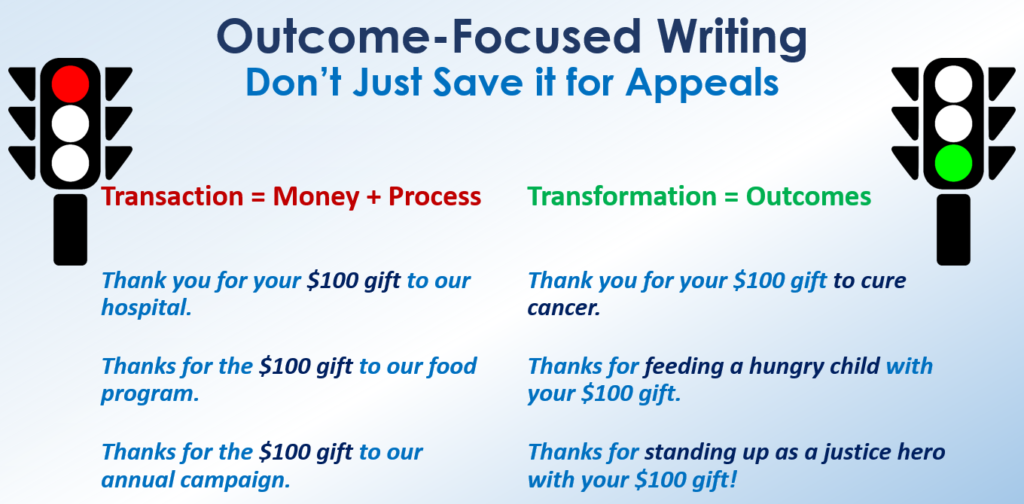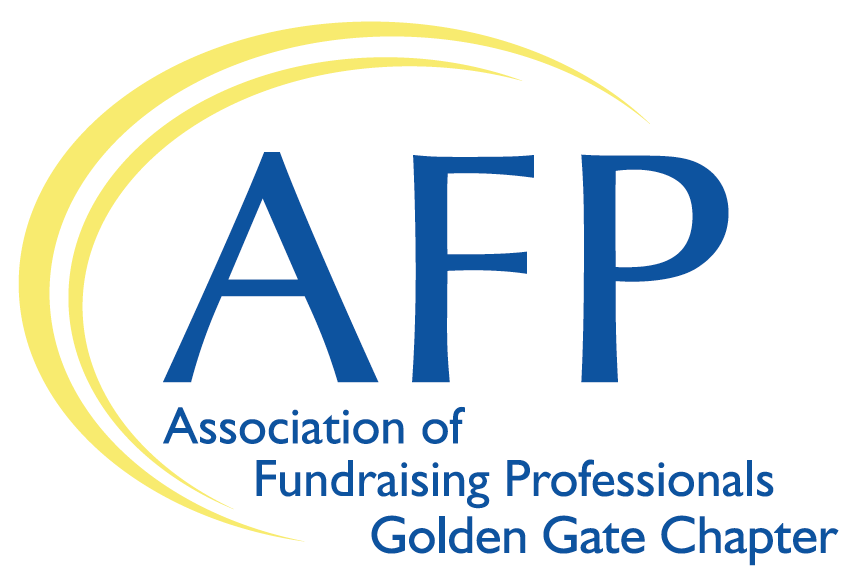13 Top Secrets of Donor Thank You Letters Revealed
By Claire Axelrad, J.D., CFRE
What do you spend more time on? Asking or thanking?
The lion’s share of nonprofits spend more time asking. It’s a BIG mistake. Don’t get me wrong. I’m not here to shame or blame you. Of course you have to ask. The number one reason people don’t give is they aren’t asked. And…
The number one reason donors don’t give again is they aren’t properly thanked!
You may think you have a proper thank you letter template. But, if your thank you looks like this, it’s not helping you bond with your supporters.
TYPICAL THANK YOU LETTER TEMPLATE
Dear [donor name],
Thank you for your generous donation of $[donation amount] to [nonprofit name].
Your donation is making a difference. Because of your $[amount] donation, we are able to [impact of donation].
[this paragraph usually gives a general description of what the organization does]
Thank you again for your contribution! [nonprofit name] relies on the gifts of donors like you to make a difference.
Sincerely,
[name and title]
Look familiar?
Wah, wah, wah (sad trombone).
Most thank you letters are simply boring.
This could come from almost any nonprofit. They’re generic, not specific. They look like a form letters.
You can do a lot better, and it’s not hard.
To Retain Donors, Stand Out From The ‘Get Go’
Believe me, most donors aren’t sticking around. Your own retention rates may be better or worse than average (do you know them?), but generally only 19% of new donors give again. For ongoing donors, it’s just 45%.
The time to nip this in the bud is now.
Did you know a study from Charity Dynamics and NTEN found 21% of donors say they were never thanked at all? My hunch is some of these supporters did receive something from you, but it was so perfunctory they didn’t really take notice. Maybe you just send a receipt. Or took them to a thank you landing page; then called it a day. Or maybe they received a brief, formal email that confirmed the gift, but didn’t make them feel particularly special.
If you don’t have a killer thank you letter prepared to send to the folks you hope will be giving to you between today and the end of the year, now is the time to right this wrong.
If You Thank Well You’ll See Retention Rates Increase Significantly.
In fact, research from Penelope Burk, author of Donor-Centered Fundraising, found 70% of donors reported they would increase their giving if they received what they needed from you.
Brilliant, warm, authentic, personal communication stands out and leads to renewals. And this is a much less expensive strategy than new donor acquisition, which costs from $1 to $1.25 to raise a dollar. Whereas renewing a donor costs only 20 cents on the dollar.
By now you may be thinking: Sounds good, but how do we stand out? There must be some specific strategies that incline donors towards giving again, but what are they?
Today I share my top secrets with you. They’re simple and foolproof.
Ready?
13 Top Secrets Of Donor Thank You Letters
SECRET TIP ONE: Consider Adding A Personalized Handwritten Note In The Right-Hand Top Margin.
This is a good place to acknowledge loyalty (e.g., “Your continued support warms our hearts,” or “You are wonderful to renew your support”), or to welcome the donor to your community (e.g., “Welcome to the Food Bank Family!”). The person who signs the letter can write this, or you can have an assistant add the note to the signed letters before you pop them in the mail. (Just be sure to use the same pen or ink color as the signature). What’s nice about this top placement is you can fold the letter so the handwriting is visible as soon as the donor opens their mail. There’s no way they aren’t going to read this letter!
SECRET TIP TWO: Use An Informal Salutation To Connote Warmth And Friendliness.
We live in casual times. Kids often call their friends’ parents, and even their teachers, by their first names. Make sure you spell their name correctly. If they use a nickname, you should too. Don’t make the awkward mistake of calling a donor “Bitty” every time you see her at meetings and events; then calling her “Beatrice” in writing. Beware of pesky first initials no one ever says out loud. Stay away from impersonal “Dear Friend” salutations. Only use a formal salutation in the following circumstances: (1) Donor asked you to; (2) Donor is a member of the clergy; (3) Donor is an elected representative or judge; (4) Donor is a member of the military.
SECRET TIP THREE: Begin With An Attention-Catching Opener.
Start with a donor centered compliment. And get right to the point with the amazing outcome the donor created. The compliment can come from you, or you can add an unexpected narrator (e.g., a tree if you’re an environmental organization; a painting if you’re an art museum; an animal if you’re a shelter, aquarium or zoo, and so forth). Jump right into the action with descriptive details enabling the donor to visualize the impact of their gift. Here are some examples:
- What you did was exceptional.
- Did you know you’re nothing short of a miracle?
- The cure is near, because of you.
- Somewhere in Ireland, a child is calling for help. And because of you, a caring voice answers.[1]
- You are the bread of life, feeding this world—feeding these children—with your compassion and kindness.[2]
- Jimmy will go to bed with a full tummy tonight – because you cared.
- You remembered, when Gloria couldn’t.
- I’m hanging on the wall of the museum today because you did an amazing thing.
SECRET TIP FOUR: Don’t Use “Thank You” And/Or A Dollar Amount In The First Sentence.
Focus instead on the outcome made possible by the donor’s gift. Put this together, as suggested above, with the wonderful qualities the donor possesses – of vision, insight, caring and generosity. The first sentence should be all about the love, not the money. Don’t forget – flattery will take you a long way.
SECRET TIP FIVE: Include A Story Snippet To Create Emotional Impact.
Consider including a close-up photo and caption, or paint a picture with carefully chosen language, to demonstrate how the donor’s gift created a positive outcome. Use powerful, descriptive words that pack a lot of punch. The photo can be printed at the top of the letter, inserted as a snapshot, or included in an email. Use headshots with the subject looking at the camera. For thank you letters, happy photos are best. The photo example here is from Vida Joven. Here are some other examples of emotion-filled story snippets.
- The glass of water he drinks today won’t make him sick.
- Look how happy Elena is with the new teddy you made possible!
- Verania is taking her college entrance exam this month, because of your love.[3]
- For an abandoned child, nothing feels better than tenderhearted kindness like yours. [4]
SECRET TIP SIX: Don’t Get Into The Weeds Or Focus Too Much On Process.
Keep it brief, personal and donor-focused. When you fall into the trap of telling your organizational story, the thank you letter can begin to be perceived as another fundraising appeal. [Again, this is one of the reasons donors report they aren’t being thanked.]
In this example from Vida Joven, the happy story arc is implied. They don’t need to go into all the details of “When Verania came here she was a mess… suffering from X, Y and Z… a victim of all sorts of horrors… utterly hopeless. But then we gave her shelter, food, counseling, school, support services and the love she needed to thrive. Last year we helped 120 girls like Verania, and with your compassion and generosity we’ll never fall short.” That may seem good to you at first blush. But look at it again from the donor’s perspective. First, it’s a bit of a downer to think about all the horrors you’ve just outlined and starts to make the donor feel they’ve merely scratched the surface. You want them feeling their gift was amazing, not like it was a drop in the bucket. Second, the laundry list of all your services is too much to process. And it sounds like you’re asking for another gift so they’ll “never fall short.” Save all the details for future emails, newsletters, blog posts and stories on your website.
SECRET TIP SEVEN: Write From The Perspective Of Transformation, Not Transaction.
When you do get to the sentence thanking them for their specific gift, put this in the form of an outcome they’re creating – not just where they sent the check.

SECRET TIP EIGHT: Acknowledge Anything Specific Your Donor Will Expect You To Acknowledge.
The thank you letter establishes trust, or breaks it. Since trust is the foundation of any lasting relationship, it’s good to be aware of anything the donor told you or showed you.
- They expect you to notice if they increased the size of their gift. “Your increased gift of $500 this year is deeply appreciated.”
- They expect you to reaffirm you’ll keep their gift anonymous. “As per your request your gift will not be publicized.”
- They want to be reassured you noticed their gift was in memory of a loved one. “Your $100 gift in Bernard Axelrad’s memory is deeply appreciated, and the family has been notified per your instructions.”
- … and so forth.
SECRET TIP NINE: Show You Want An Ongoing Relationship.
Let the donor know how and when you’ll next be in touch. For example, if you tell them they’ll soon receive an invitation to a free event, they can anticipate this – extending the warm glow they felt when they gave. Plus, when you follow through as promised, it helps establish trust.
Be sure to give them personal contact information so they have a real person to connect with should they have any questions or needs in the future.
SECRET TIP TEN: Close Warmly And Authentically.
“Sincerely” is a bit formal and does nothing to build a relationship. A thank you letter is a place to gush a little. Instead, try something heartfelt or mission related.
- In gratitude,
- Warmly,
- With appreciation and admiration,
- For the love of theater,
- In celebration of you,
- From the bottom of my heart,
The best signatures appear authentic. Ideally, hand write them. If you lack the bandwidth for this, make sure they’re at least printed in a color that differs from the rest of the letter (e.g., blue ink).
SECRET TIP ELEVEN: Add A Personalized, Handwritten Note Next To The Signature.
What you write in handwriting will be noticed more than anything else in the letter. It’s too easy for thank you notes to appear cold and impersonal. The equivalent of a Hallmark card with a pre-printed message, to which all you add is your John Hancock. The added note can be as simple as “Your (increased) gift means a lot!” Or “Thanks so much!” Or “I look forward to seeing you soon!”
It’s not so much what you say, as the fact you took the extra time to say it. This is something donors notice, and it makes them feel special.
SECRET TIP TWELVE: Don’t Forget The P.S.
The P.S. is your most valuable piece of real estate as eye motion studies reveal it’s often read first. It’s a great place to suggest future engagement or call attention to a special insert (e.g., a thank you note or testimonial from someone they helped; a list of volunteer opportunities; some heart stickers to show your love).
SECRET TIP THIRTEEN: Put Your Tax Information To Work!
Remember I said not to say “thank you for your $XX gift as the first sentence? You can actually avoid talking about money at all in the body of the letter. Save it for the fine print at the bottom of the letter where you provide information they may need for tax purpose. Include gift amount, date of the gift and your tax ID #. Here is a truly warm example from Vida Joven (I’d just add the date of gift to make it really easy for the donor to use for their tax reporting purposes):
“Your donation of $XX is tax-deductible to the extent allowed by law. Vida Joven de México is a 501(c) (3) nonprofit organization. Taxpayer ID #47-1838706. Aside from the really great feeling you get from changing a child’s life, you haven’t received any goods or services in exchange for your gift.”
BONUS TIP: Review Your Letter To Assure It’s More Donor-Centric Than Ego-Centric.
Some call this the “you, your” vs. the “I, my, we, our, us, [name of your organization]” test. You want a lot of the former; very little of the latter. As the donor reads the letter, they should see themselves there. “You did it!” is much better than “Your money helped us do it.”
 Claire, J.D., CFRE, is a former AFP-GGC board member and 2010 recipient of the AFP “Outstanding Fundraising Professional of the Year” award. After a 30-year in-the-trenches development career, Claire began her own coaching/teaching practice in 2011. Her Clairification School has been called “the best bargain in fundraising!” She also curates a biweekly e-newsletter, the “Clairity Click-it,” offering free nonprofit resources found across the web, and serves as featured expert and Chief Fundraising Coach for Bloomerang. A member of the California State Bar and graduate of Princeton University, Claire currently resides in San Francisco California.
Claire, J.D., CFRE, is a former AFP-GGC board member and 2010 recipient of the AFP “Outstanding Fundraising Professional of the Year” award. After a 30-year in-the-trenches development career, Claire began her own coaching/teaching practice in 2011. Her Clairification School has been called “the best bargain in fundraising!” She also curates a biweekly e-newsletter, the “Clairity Click-it,” offering free nonprofit resources found across the web, and serves as featured expert and Chief Fundraising Coach for Bloomerang. A member of the California State Bar and graduate of Princeton University, Claire currently resides in San Francisco California.
